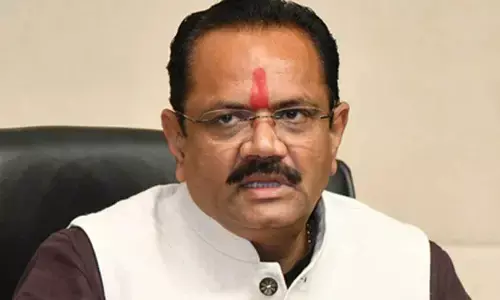Forgotten stepwells: A peep into State’s history

- The work explores the historic precincts and colonies ‘Baolis of Hyderabad’
- During the Kakatiya rule, step wells played a crucial role in capturing rainwater efficiently
- Unlike Gujarat, step wells in TS are designed with a focus on functionality
Hyderabad: To discover, explore, and document the unknown yet significant presence of the fascinating yet forgotten step wells in Telangana, The Hyderabad Design Forum, led by its President Yeshwant Ramamurthy and his team envisioned and curated “The Forgotten Stepwells of Telangana”, which was recently released. Narrating the journey in the documentation of these step wells and about the work to The Hans India, he said, “Stepwells, found in various forms like those linked to agricultural lands, forts, temples, and urban areas, serve as reservoirs of water.
They primarily focus on collecting water when it is plentiful and ensuring access during times of scarcity. Throughout history, civilisations have centered on water sources, be it rivers or lakes, crucial for human sustenance. Water, essential for more than just drinking, held significant cultural and religious importance, extending to worship practices.”
In this book, ‘An Ode to Water’ written by Sneha Parthasarthy, she embarks on a journey across India to explore and study stepwells. Her research delves into regional nuances, tracing the evolution of water systems from as early as the 4th century BC to modern times. In SrivalliPradeepthiIkkurthy’s work, “The Reasoning, Relation, and Positioning of Water,” the focus lies on elucidating the significance of water in ancient Hindu scriptures. She explicates why water occupies a position towards the Northeastern side of temples. Additionally, it highlights the connection between this placement and the magnetic North, underscoring how the magnetic North determines the positioning of water within these sacred spaces. Adding further, Ramamurthy said, ‘Baolis of Hyderabad’ in the book delves into the intricate relationship between the precincts and colonies in Hyderabad, particularly known as ‘Baghs,’ such as Basheerbagh and Ibrahimbagh. These areas, once part of a city referred to as ‘Baghnagar,’ encompassed numerous gardens and colonies with Baolis(step wells) as integral components. Notably, colonies like Putlibowli were identified by the presence of these Baolis, emphasising their historical significance within the cityscape.
In the Hydrology and Geomorphology of Telangana, by Mounika Dereddy the focus is on the composition of soils found within stepwells. The narrative extends to encompass various aspects, including rainfall patterns, water sources, groundwater table levels, and the geological composition of rocks as it delves into how Baolis was created, referencing unique formations like ant hills or snake pits that facilitated consistent hydration within these structures. Additionally, it explores the significance of trees like the Jamun tree in contributing to the sustained moisture levels within the Baolis.
Professor Neheema Shahnawaz talked about decoding the construction of technologies of step wells which include the stone size, soil bearing capacity, sand and lime mortar in the step wells, and others.
Stepwells served a pivotal role in the irrigation system, particularly during the Kakatiya rule in Telangana. The Kakatiyas ingeniously designed bunds and structures to capture rainwater efficiently. These step wells became crucial reservoirs, storing water from the monsoons, thereby ensuring a consistent water supply for agriculture. Even today, many villages in the region continue to rely on this age-old system of harnessing monsoon water for their agricultural needs, showcasing the enduring legacy and practicality of these ancient water conservation methods.
Srivalli Pradeepthi Ikkurthy says unlike in Gujarat where step wells are carved, in Telangana they are functional and do not have much carving, and iconography is connected with mythology. Aparna Bidarkar highlights an intriguing perspective on the connection between water and women beyond the mere act of water collection. According to her, water spaces served as more than utilitarian sources; they became hubs for social interaction. These areas provided women with opportunities for leisure, enjoyment, and entertainment, offering free time for socialising and fostering connections within the community. Beyond its functional role, water became an integral part of social life, especially for women, providing spaces for interaction and camaraderie.
Looking toward the present dereliction and future redemption of the step wells, Yeshwant Ramamurthy brings forth a narrative encapsulating both hope and despair regarding the state of these step wells. While some of these wells might have dried up, there is an inspiring aspect to their adaptation for reuse. Many residents have repurposed these spaces for various cultural and social activities, transforming them into venues for photography sessions, weddings, fashion shoots, and cultural events like music and dance performances. This rejuvenation has rekindled people’s attachment to these structures, turning them into popular destinations for cultural engagements. Architects have also played a role by conceptualising courtyards and interactive spaces within these wells, fostering social engagement and providing avenues for interaction and enjoyment. The essays in the book are peppered with feature stories by the editor and Kalpana Ramesh.














